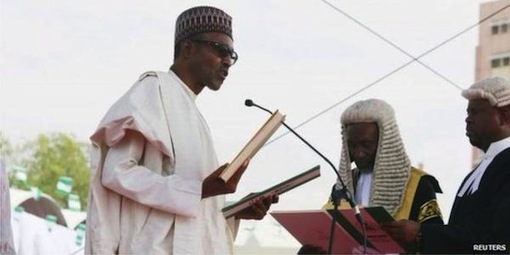30th May, 2015

Lagos (AFP) – President Muhammadu Buhari was sworn in as Nigeria’s new president on Friday but he will find that Nigeria has changed drastically compared to when he was at the helm more than 30 years ago.
STATS:
– People –
Nigeria’s population reached 173 million in 2014, according to the World Bank, against 100 million in 1984-1985, a growth of 73 percent over three decades.
Life expectancy at birth was 53 years in 2013, up from 46 in 1984-1985.
Infant mortality dropped by 60 percent in almost 30 years, with 76 deaths per 1000 births in 2012 against 125 in 1984-85.
The country comprises about 250 ethnic and linguistic groupings.
The three largest ethnic groups are the Hausa in the north, the Igbos in the southeast and the Yoruba in the southwest.
Muslims, who live predominantly in the north, and Christians in the south each represent about a half of the population. Animist rites are practised by a minority.
– Economy –
Oil provides 90 percent of Nigeria’s foreign exchange earnings. The country is currently the eighth exporter of oil in the world and the biggest in Africa.
It pumps about two million barrels of crude per day against 1.4 million in 1984-85 but is still reliant on imports of fuel products due to a lack of functioning refineries.
Nigeria’s natural gas reserves are the eighth biggest in the world. After years of unrest in the oil-producing Niger Delta in the south, which led to a fall in its production, oil production has increased since 2012.
Nigeria in April 2014 became the biggest economy in Africa with a revised GDP of $521.8 billion (2013), overtaking continental powerhouse South Africa.
Income per capita came to $2,710 in 2013, compared to just $400 in 1987.
The country has seen an annual growth of 7.0 percent over the past decade, making it a target for overseas investors. But most of the population lives in poverty, with vast differences in development and standards of living in the north and south.
While a part of the population has profited from development of the banking and telecommunications sectors, a majority of the population lives on less than two dollars a day.
– Electricity –
Nigeria lacks crucial infrastructure and power cuts take place on a daily basis. In 2014 electricity production was 3,000 megawatts a year, against 2,300 at the end of the 1980s, well below the population’s needs.
Last Friday, the government said production was at a record low of just 1,327 megawatts.
– History –
Before the arrival of Europeans, the region that is now Nigeria was home to various kingdoms and city-states. The appearance of European slave traders from the late 15th century had a profound effect on the region.
In the 19th century, the gradual abolition of the slave trade went hand-in-hand with increasing colonisation by Britain and the penetration of Christianity, particularly in the south.
Nigeria achieved independence from Britain in 1960.
A bid for secession in the mainly Igbo region of Biafra in the southeast led to a civil war that left about one million people dead from combat, illness and starvation between 1967 and 1970.
Nigeria’s post-independence history has been marked by six military coups but it has been ruled by civilian governments since 1999.
Recent years saw major unrest in the southern Niger Delta from militants demanding a larger share of oil revenues.
The country also suffers from periodic violence between Christian and Muslim ethnic groups in its central region.
The Islamist group Boko Haram has been fighting an insurgency in the northeast since 2009, which has claimed more than 15,000 lives and displaced at least 1.5 million people.


